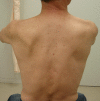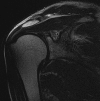SLAP repair with arthroscopic decompression of spinoglenoid cyst
- PMID: 27163090
- PMCID: PMC4849274
- DOI: 10.1051/sicotj/2015036
SLAP repair with arthroscopic decompression of spinoglenoid cyst
Abstract
Introduction: A spinoglenoid cyst with suprascapular nerve disorders is highly associated with superior labrum anterior posterior (SLAP) lesion. Conservative or surgical treatment is applied to relieve pain and neurological symptoms. The purpose of this study was to evaluate clinical outcomes of patients treated by arthroscopic surgery for SLAP lesion with a spinoglenoid cyst.
Methods: The subjects of this study were six patients with SLAP lesion with a spinoglenoid cyst who underwent arthroscopic surgery. There was one female and five males with a mean age of 48.5 years. SLAP lesion was found in all the patients at arthroscopy. A small tear of the rotator cuff was found in the two patients. The SLAP lesion was repaired using suture anchors, and the rotator cuff tears were repaired by suture-bridge fixation. The spinoglenoid cyst was decompressed through the torn labrum in three patients, and through the released superior to posterior portion of the capsule in the other three patients.
Results: All patients showed excellent improvement in pain and muscle strength at the final follow-up examination. The mean Constant score was improved from 60.5 points preoperatively to 97.2 points postoperatively. The mean visual analog scale (VAS) score decreased from 4.5 on the day of the surgery to 2.5 within one week postoperatively. Postoperative MRI showed disappearance or reduction of the spinoglenoid cyst in four and two patients, respectively. There were no complications from the surgical intervention and in the postoperative period.
Discussion: The patients treated by decompression through the released capsule obtained pain relief at an early period after the surgery. Arthroscopic treatment for a spinoglenoid cyst can provide a satisfactory clinical outcome. Arthroscopic decompression of a spinoglenoid cyst through the released capsule is recommended for a safe and reliable procedure for patients with suprascapular nerve disorders.
Keywords: Arthroscopic decompression; Labral tear; SLAP repair; Spinoglenoid cyst; Suprascapular nerve.
Figures





Similar articles
-
Arthroscopic Decompression of Spinoglenoid Notch Cyst and SLAP Repair Through a Single Working Portal.Arthrosc Tech. 2018 Aug 27;7(9):e963-e967. doi: 10.1016/j.eats.2018.05.004. eCollection 2018 Sep. Arthrosc Tech. 2018. PMID: 30258779 Free PMC article.
-
Clinical Outcomes Following Arthroscopic Decompression and Repair versus Repair Alone in Patients with a Concomitant Spinoglenoid Cyst and SLAP Lesion: A Systematic Review.Diagnostics (Basel). 2023 Jul 13;13(14):2364. doi: 10.3390/diagnostics13142364. Diagnostics (Basel). 2023. PMID: 37510107 Free PMC article. Review.
-
Compression of the suprascapular nerve by a ganglion cyst of the spinoglenoid notch: the arthroscopic solution.Knee Surg Sports Traumatol Arthrosc. 2004 Jan;12(1):72-9. doi: 10.1007/s00167-003-0443-y. Epub 2003 Nov 1. Knee Surg Sports Traumatol Arthrosc. 2004. PMID: 14595536
-
Greater strength increase with cyst decompression and SLAP repair than SLAP repair alone.Clin Orthop Relat Res. 2011 Apr;469(4):1056-60. doi: 10.1007/s11999-010-1661-5. Clin Orthop Relat Res. 2011. PMID: 21104358 Free PMC article.
-
Arthroscopic Management of SLAP Lesions With Concomitant Spinoglenoid Notch Ganglion Cysts: A Systematic Review Comparing Repair Alone to Repair With Decompression.Arthroscopy. 2018 Jul;34(7):2247-2253. doi: 10.1016/j.arthro.2018.01.031. Epub 2018 Feb 28. Arthroscopy. 2018. PMID: 29501216
Cited by
-
Arthroscopic management of suprascapular neuropathy of the shoulder improves pain and functional outcomes with minimal complication rates.Knee Surg Sports Traumatol Arthrosc. 2018 Jan;26(1):240-266. doi: 10.1007/s00167-017-4694-4. Epub 2017 Sep 6. Knee Surg Sports Traumatol Arthrosc. 2018. PMID: 28879607
-
Arthroscopic management of spinoglenoid notch cysts: with and without labral lesions.BMC Musculoskelet Disord. 2025 Aug 16;26(1):796. doi: 10.1186/s12891-025-09074-0. BMC Musculoskelet Disord. 2025. PMID: 40818948 Free PMC article.
-
High rates of return to sport after suprascapular nerve decompression: an updated systematic review.JSES Rev Rep Tech. 2024 Jun 1;4(4):654-661. doi: 10.1016/j.xrrt.2024.05.007. eCollection 2024 Nov. JSES Rev Rep Tech. 2024. PMID: 39474168 Free PMC article. Review.
-
Additive effect of glenohumeral joint hydrodilatation applied in addition to suprascapular nerve blockage in patients with adhesive capsulitis.BMC Musculoskelet Disord. 2024 Nov 22;25(1):945. doi: 10.1186/s12891-024-08082-w. BMC Musculoskelet Disord. 2024. PMID: 39578761 Free PMC article. Clinical Trial.
-
The role of suprascapular nerve block in hydrodilatation for frozen shoulder.SICOT J. 2022;8:25. doi: 10.1051/sicotj/2022026. Epub 2022 Jun 14. SICOT J. 2022. PMID: 35699461 Free PMC article.
References
-
- Callahan JD, Scully TB, Shapiro SA, Worth RM (1991) Suprascapular nerve entrapment. A series of 27 cases. J Neurosurg 74, 893–896. - PubMed
-
- Ide J, Maeda S, Takagi K (2003) Does the inferior transverse scapular ligament cause distal suprascapular nerve entrapment? An anatomic and morphologic study. J Shoulder Elbow Surg 12, 253–255. - PubMed
-
- Drez D (1976) Suprascapular neuropathy in the differential diagnosis of rotator cuff injuries. Am J Sports Med 4, 43–45. - PubMed
-
- Semmler A, von Falkenhausen M, Schroder R (2008) Suprascapular nerve entrapment by a spinoglenoid cyst. Neurology 70, 890. - PubMed
LinkOut - more resources
Full Text Sources
Other Literature Sources
